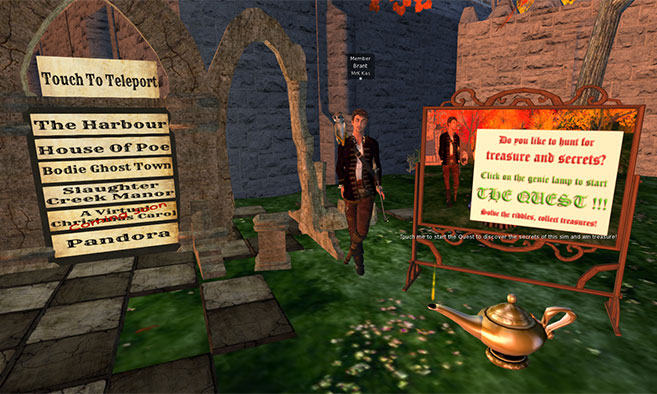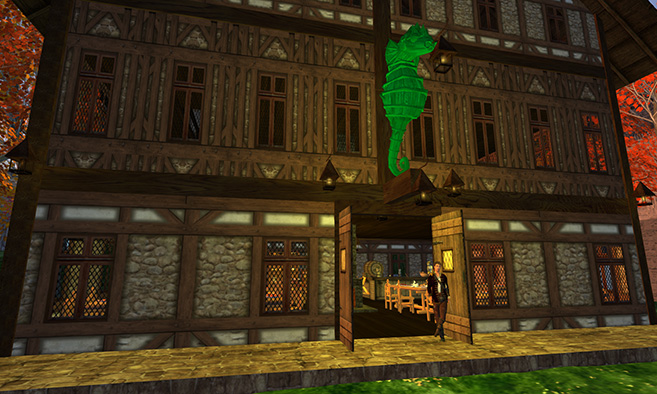Teaching Development Grants – Co-Investigator
HKU Faculty of Medicine – Teaching development studies for Biochemistry and Pathology were developed in the virtual environment of Second Life on “HKU Medicine Island”. These studies sought to supplement classroom instruction by blending in experiential learning in an immersive environment. The Moodle LMS platform was used to set the context, define the problem for inquiry-based learning, launch the virtual environment, and debrief the students using quiz and discussion activities.
1) HKU Faculty of Medicine – Biochemistry – using the virtual environment to create student training simulations for interviewing patients and doing experiments on lab benches. Example videos: Patient interview, Lipoprotein experiment
PI: Dr. Joanna Ho, University of Hong Kong
Co-Is: NS Wong, Brant Knutzen
2) HKU Faculty of Medicine – Pathology – using the virtual environment to create a self-accessed training scenario for using lab equipment safely. Example video: Fire Safety
PI: Prof UI Khoo, University of Hong Kong
Co-I: Brant Knutzen
3) Academy of Medicine (Hong Kong Jockey Club funding) – tour of the Innovative Learning Centre – developed a Virtual Tour of their new Innovative Learning Centre (ILC) for Medicine (training using simulation – 6 minutes). The goal of this project is to prepare the medical students and practitioners who are scheduled for professional development training at the real-world ILC by familiarizing them with the facility layout, equipment available, and even the training simulations themselves! Can exploring a virtual simulation in a replica prepare students so their experience in a physical facility is more effective and satisfying?
General Research Fund study – Co-Investigator
Critical Investigation of Stage-to-screen and Screen-to-stage Adaptation Discourses: An Analysis of Key Terms and Practices
PI: Dr. Mike Ingham, Lingnan University
This project seeks to explore an under-theorised area: namely the interface between film and theatre studies and the intersection of the two disciplines and practices in the form of intermedial adaptation. Example video 1, Example v
On HKU Education Island I have worked with three partners to explore the application of virtual world technology to create an immersive literary experience: a winter wonderland celebrating Dickens’ classic Victorian tale: A Christmas Carol !
We have recreated eight pivotal scenes in a snowy winter setting to bring this classic Victorian literature alive as an immersive experience, a sort of “3-D graphic novel”.
The interactive journey begins with Scrooge’s “Bah humbug!” scene with his nephew in his counting-house, moves to his fateful visit that night from Marley’s ghost, and then visitors can interactively explore key scenes from Past, Present, and Future Christmases. Students can choose where they go, how fast and to what depth to explore scenes, and can click on the characters to hear what they are thinking! This build was selected for presentation by the 2017 Virtual Worlds Best Practices in Education conference, in the Immersive Experiences track!
Two examples of student videos produced by this training project:
Effects of human pollution on environment
The Seek
HK Education University – I recently put together a project proposal with Professor KF Kenneth Sin of the Special Education & Counseling department at the Education University, with a focus on the training of teachers for Gifted Education. Below is the video produced as a proof of concept, based on customized Asian and mixed-race child avatars wearing Hong Kong-specific school sports uniforms. (Voice acting by me and my kids!):
Teaching Development
Lingnan Digital Literacy project – a grant-funded project exploring the application of the virtual world to training students about digital literacy. As part of this project, a full region called Lingnan Drama Island in Second Life has been developed as a medieval village called Camelot. Students start with the Quest, a 10-step hunt following riddle clues, to explore the sim and learn the basic navigation and user interface skills.
Example video: Overview of the Quest presentation at the VWBPE conference
This build was selected for presentation by the 2016 Virtual Worlds Best Practices in Education conference, in the Immersive Experiences track!
Another area I have explored as part of my research is the gamification of student training in the virtual world. I developed the Pirate Ship Battle Game to gamify the training of camera controls: zoom, pan, etc. These psycho-motor skills are essential to the smooth production of digital storytelling using the virtual world!
CURRENT RESEARCH PROJECT: based on all the lessons I learned from the Quest project I am creating a gamified virtual environment to investigate collaborative group behaviors, which I am calling “The Agency“. In Jan 2018 I wiped out the Quest environment (a medieval village) and terraformed the virtual space into my interpretation of the ancient canal city of Venice, Italy! I bought some “Giudecca” houses and a Venetian palace on the SL Marketplace, and did a heck of a lot of interior decorating to create a ducal palazzo, several restaurants, the Aldine printing shop (complete with Gutenberg presses), and a library, all designed to evoke the early Renaissance period of the 1600’s!
I also invited several people who own stores on the SL Marketplace to set up their shops along the canals to sell their ware: Venetian period clothes, jewelry, and masks for the Carnival celebration!
After several “alpha” tests with various people I think I’ve just about got the Pirate Ship Battle game ready for prime time as Mission #1 of a gamified environment, designed to train people how to use advanced camera controls in the virtual world of Second Life as part of a group collaborative activity.
I have given presentations / tours of this gamified learning environment to several groups, including the Virtual Worlds Best Practices in Education (VWBPE) 2018 conference in March, the International Society for Technology in Education (ISTE) and the GUINEVERE project in June. Below is a 80-minute recording of the presentation for the Guinevere project members as a shared desktop in an Adobe Connect web conference room, with most of the participants also represented as avatars in Second Life:
The attendees for the GUINEVERE presentation gave it very positive feedback, read about it in their June newsletter here.


